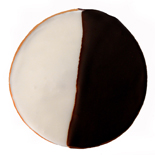 Not strictly environmental news, but on the closely-related topics of human health and consumer habits:
Not strictly environmental news, but on the closely-related topics of human health and consumer habits:
The City of New York has asked local restaurants to voluntarily hold the fat by switching from extremely heart-unhealthy transfats — found in partially hydrogenated vegetable oil — to healthier fats like sunflower and olive oils in their dishes.
Our famous black-and-white cookies are apparently impossible to make without transfats, but not all local treats will suffer. After all these years of considering butter and beef fat the anti-Christ, the data on transfats renders (heh) foods prepared in or prepared with animal fats less evil than their hydrogenated counterparts:
Not all of New York’s beloved foods will suffer. Balthazar’s French fries rely on healthier peanut oil, which is to frying oils what Manolo Blahnik is to shoes. Magnolia Bakery uses butter in its cupcakes. On the rare occasion that the Magnolia bakers make a pie, they use a new version of Crisco without trans fat, said Allysa Torey, the owner.
Even without a lot of cash, food-loving New Yorkers can find ways to avoid trans fats. At Katz’s Deli on the Lower East Side, the thick-cut French fries that go so well with a pastrami sandwich are fried, as they always have been, in beef tallow.
Denmark’s had a law severely limiting the percentage of trans fats in a food item’s total fats since 2003, and Canada’s considering a similar rule.
My initial response is to wonder if such measures can catch on in America, where the freedom to choose from various modes of self-destruction is practically a national religion. But … what if we didn’t have to choose? What if there were ways to have our junk food guilt-free?Apparently, every major food producer and food-ingredient company is employing scientists to find ways to turn bad, fattening junk food into happy, healthier junk food. Though the details sometimes read a little squicky, you have to admit that the outcome sounds promising for both palette and poundage: Breaded chicken, doused in a liquid made from “water and protein molecules extracted from a slurry of chicken or fish tissue,” and dunked in the fryer, come out with 50 percent less fat than a typical piece of fried chicken.
Fish oil microcapsules in bread, fiber-increasing additives in corn chips. What’s not to love?
Well, my gut (hah) reaction is that these kinds of processing innovations increase the distance between human beings and the basic nature of the sustenance provided by plants or animals. Half-fat fried chicken does not teach anyone to simply consume less if they want to lose weight. And it would be naive not to take the motivations of the food companies spending millions on this research with, uh, a grain of salt, especially as they start slapping the label “healthy” on everything with a bit of added fiber or omega-3 fatty acids. Processed foods usually sell for a lot more per pound than their raw ingredients, so these companies sure don’t want Americans giving up tater tots for whole potatoes.
Still, let’s face it: Even though heart disease and obesity are major health problems for millions today, trends don’t seem to suggest that Americans are giving up their fried chicken and french fries any time soon.
Some nutritionists wonder if these altered foods are just going to confuse people more about nutrition. Probably. But how relevant is that to the average American anymore? To make an environmentalist analogy, knowing car emissions contribute to climate change isn’t getting enough people onto bicycles. And hybrids are a definite improvement on the automotive alternatives. So it’s better to find ways to improve the foods people actually are eating today, and worry later about getting Americans more in touch with what they’re consuming.
 Not strictly environmental news, but on the closely-related topics of human health and consumer habits:
Not strictly environmental news, but on the closely-related topics of human health and consumer habits: 
